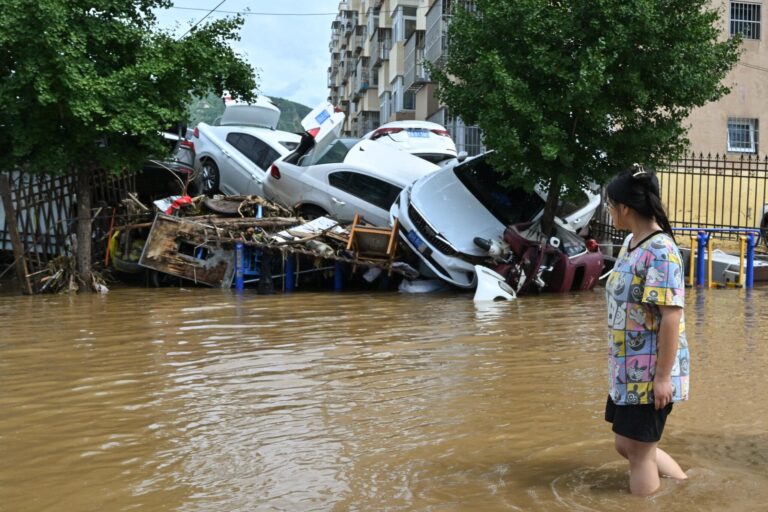Severe flooding has struck Beijing, resulting in the deaths of at least 30 people and forcing the evacuation of approximately 80,000 residents. The extreme weather conditions overwhelmed the city’s infrastructure, causing widespread damage and disrupting daily life. Authorities are continuing rescue and relief efforts as they assess the full impact of the disaster.
China Floods Devastate Beijing with Hundreds of Thousands Displaced
The recent deluge hitting Beijing has led to unprecedented challenges for city officials and residents alike. Torrential rains triggered severe flooding in multiple districts, forcing emergency services to mobilize swiftly in response to the escalating crisis. Authorities confirmed that at least 30 lives have been lost due to drowning and infrastructure collapses, while an estimated 80,000 people have been evacuated from vulnerable areas. Floodwaters submerged entire neighborhoods, disrupting transportation, communication, and essential utilities, leaving many trapped or stranded without access to basic necessities. Relief efforts are currently focused on rescuing those in immediate danger and providing shelter for displaced families.
In addition to human casualties, the floods have inflicted significant damage on Beijing’s infrastructure and economy. Critical roadways remain underwater, complicating logistics and emergency response. Public health concerns are rising as stagnant floodwaters increase risks of waterborne diseases. Below is a snapshot of the current impact across key affected districts:
| District | Evacuations | Infrastructure Damage | Emergency Response Status |
|---|---|---|---|
| Chaoyang | 25,000 | Severe road closures | Active rescue operations |
| Haidian | 15,000 | Power outages in multiple areas | Medical aid deployed |
| Xicheng | 10,000 | Flooded residential buildings | Temporary shelters established |
- Emergency shelters are being set up across schools and government buildings.
- Military assistance has been requested to support evacuation and relief.
- Weather warnings remain in effect as authorities brace for further rainfall.
Emergency Response Efforts Intensify Amid Rising Death Toll
Rescue teams and local authorities are racing against time as the recent flooding wreaks havoc across Beijing. Rapid deployments of emergency personnel, including firefighters, paramedics, and volunteers, have been mobilized to assist the tens of thousands displaced from their homes. Temporary shelters have been established in key locations, offering safe refuge and essential supplies to evacuees. Critical infrastructure restoration efforts are also underway, focusing on clearing blocked roads and restoring power to flooded neighborhoods.
Coordination between municipal agencies and the military has proven essential in managing the crisis. Helicopter evacuations, water rescues, and distribution of relief materials are being prioritized to reach the most isolated communities. Below is a snapshot of the ongoing emergency response operations:
| Operation | Resources Deployed | Status |
|---|---|---|
| Helicopter Evacuations | 5 choppers, 20 crew | Active |
| Temporary Shelters | 15 centers, 8,000 beds | Operational |
| Water Rescue Teams | 100 personnel, 10 boats | Ongoing |
| Power Restoration | 30 technicians | In Progress |
- Over 80,000 residents evacuated to date, with more expected as floodwaters continue to rise.
- Emergency hotlines have been expanded to assist affected individuals with urgent needs.
- Continuous rain forecast complicates rescue and recovery efforts moving forward.
Experts Urge Infrastructure Upgrades and Improved Flood Preparedness Measures
In the wake of the devastating floods that have swept through Beijing, experts are calling for urgent upgrades to the city’s infrastructure to mitigate future disasters. Urban planners and environmental specialists emphasize the need for enhanced drainage systems capable of handling extreme rainfall, alongside the modernization of existing water barriers. Current networks, many of which date back several decades, are proving insufficient against increasing climate volatility, underscoring the pressing vulnerability of Beijing’s metropolitan area.
Key recommendations put forward by specialists include:
- Expanding and reinforcing flood control reservoirs and levees
- Implementing smart water management technologies for real-time monitoring
- Improving early warning systems to facilitate faster evacuations
- Enhancing community preparedness with regular drills and educational programs
| Measure | Expected Impact | Timeline |
|---|---|---|
| Infrastructure Modernization | Reduced flooding risk in urban zones | 3-5 years |
| Advanced Monitoring Systems | Faster response times | 1-2 years |
| Community Education Programs | Higher public awareness | Ongoing |
The Conclusion
As rescue efforts continue and floodwaters gradually recede, authorities in Beijing remain on high alert, working to provide relief and support to those affected. The recent deluge serves as a stark reminder of the growing challenges posed by extreme weather events in the region. Further updates are expected as emergency teams assess the full extent of the damage and aid operations progress.




